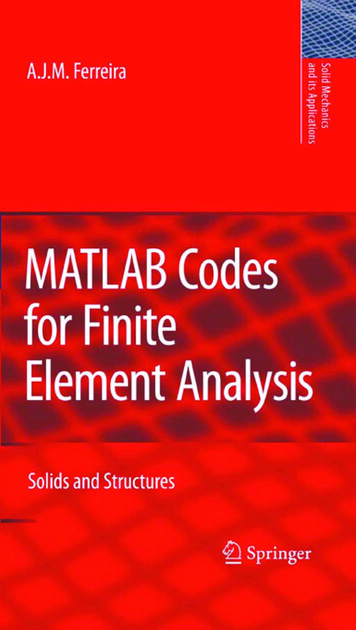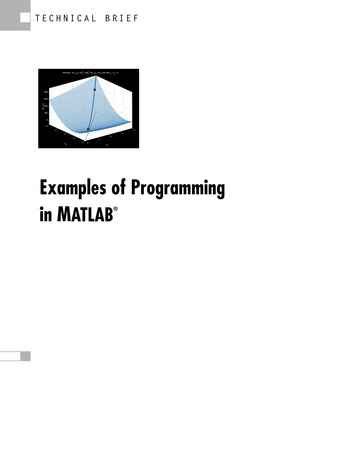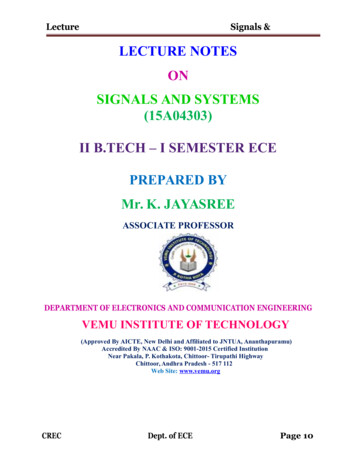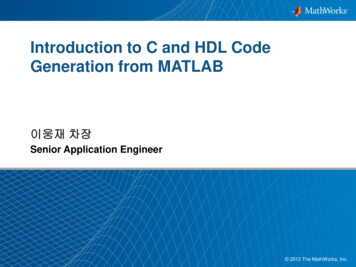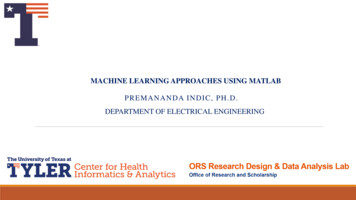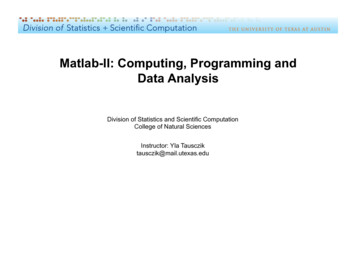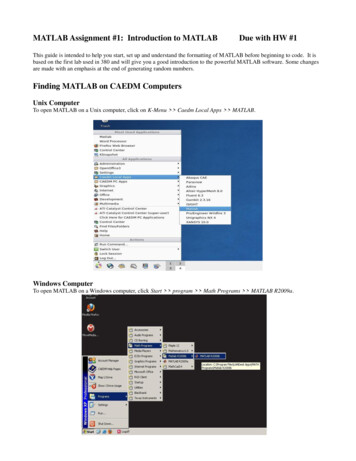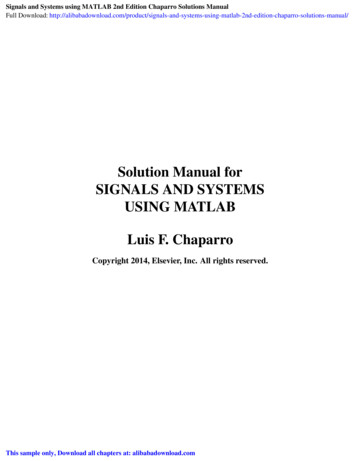
Transcription
Signals and Systems using MATLAB 2nd Edition Chaparro Solutions ManualFull Download: anual/Solution Manual forSIGNALS AND SYSTEMSUSING MATLABLuis F. ChaparroCopyright 2014, Elsevier, Inc. All rights reserved.This sample only, Download all chapters at: alibabadownload.com
Chapter 0From the Ground Up0.10.1Basic Problems(a)i. Re(z) Im(v) 8 2 6ii. z v 17 j1 172 1iii. zv 72 j16 j27 6 78 j11 782 112iv. z v tan 1 (3/8) tan 1 (2/9)v. v/z v / z 85/ 73vi. (v/z) tan 1 (2/9) tan 1 (3/8) 1(b) i. z v 17 j 172 1ej tan (1/17) 1ii. zv 78 j11 782 112 ej tan (11/78) 1 1iii. z 8 j3 64 9(e j tan (3/8) ) 73ej tan (3/8)iv. zz z 2 73 1v. z v 1 j5 1 25e j tan (5)1
Chaparro — Signals and Systems using MATLAB0.2(a) z 6ejπ/4 6 cos(π/4) j6 sin(π/4) i. Re(z) 6 cos(π/4) 3 2 ii. Im(z) 6 sin(π/4) 3 2(b)i.ii.iii.iv.Yes, Re(z) 0.5(z z ) 0.5(2Re(z)) Re(z) 8Yes, Im(v) 0.5j(v v ) 0.5j(2jIm(v)) Im(v) 2Yes, Re(z v ) Re(Re(z) Re(v ) Im(z) Im(v)) Re(z v) 17Yes, Im(z v ) Im(17 j5) Im(z v) Im( 9 j5) 5Copyright 2014, Elsevier, Inc. All rights reserved.0.2
Chaparro — Signals and Systems using MATLAB0.30.3 (a) Representing the complex number z x jy z ejθ then x z cos(θ) and since cos(θ) 1then x z , the equality holds when θ 0 or when z x, i.e., it is real.(b) Adding two complex numbers is equivalent to adding two vectors to create a triangle with two sidesthe two vectors being added and the other side the vector resulting from the addition. Unless the twovector being added have the same angle, in which case z v z v , it holds that z v z v .!z !v!v!zFigure 1: Addition of two vectors illustrating the triangular inequality.(c) The answer to both is yes. Indeed, (a) z v 13 z v 2 5 (b) z v 1 1 z v 2 5Copyright 2014, Elsevier, Inc. All rights reserved.
Chaparro — Signals and Systems using MATLAB0.40.4(a) We havei. cos(θ π/2) 0.5(ej(θ π/2) e j(θ π/2) ) j0.5(ejθ e jθ ) sin(θ)ii. sin(θ π/2) 0.5j(ej(θ π/2) e j(θ π/2) ) 0.5j( j)(ejθ e jθ ) cos(θ)iii. sin(θ π/2) (jejθ je jθ )/(2j) cos(θ)(b)i. cos(2πt) sin(2πt) (1/4j)(ej4πt e j4πt ) so thatZ1cos(2πt) sin(2πt)dt 01 ej4πt 11 e j4πt 1 0 0 0 04j 4πj4j 4πj 0ii. We have11 j4πt(e 2 e j4πt ) (1 cos(4πt))42so that its integral is 1/2 since the integral of cos(4πt) is over two of its periods and it is zero.cos2 (2πt) Copyright 2014, Elsevier, Inc. All rights reserved.
Chaparro — Signals and Systems using MATLAB0.5(a)0.5i. 2 cos(α β) ej(α β) e j(α β) (ejα ejβ ) (ejα ejβ ) 2Re(ejα ejβ ) andRe[ejα ejβ ] Re[(cos(α) j sin(α))(cos(β) j sin(β))] cos(α) cos(β) sin(α) sin(β)so thatcos(α β) cos(α) cos(β) sin(α) sin(β)ii. 2j sin(α β) ejα ejβ (ejα ejβ ) 2jIm[ejα ejβ ], and the imaginary issin(α) cos(β) cos(α) sin(β) sin(α β)(b)Z1ej2πt dt 0alsoZ01ej2πt dt Zej2π 1ej2πt 1 0 0j2πj2π1cos(2πt)dt j0Z1sin(2πt)dt 0 j00since the integrals of the sinusoids are over a period.(c)i. Yes, ( 1)n (ejπ )n ejnπ cos(nπ) j sin(nπ) cos(nπ) since sin(nπ) 0 for anyinteger n.ii. Yes, ej0 ejπ and ejπ/2 ej3π/2 so they add to zero.Copyright 2014, Elsevier, Inc. All rights reserved.
Chaparro — Signals and Systems using MATLAB0.60.6 (a) Using Euler’s identity the productejα ejβ (cos(α) j sin(α))(cos(β) j sin(β)) [cos(α) cos(β) sin(α) sin(β)] j[sin(α) cos(β) cos(α) sin(β)]whileej(α β) cos(α β) j sin(α β)so that equating the real and imaginary parts of the above two equations we get the desired trigonometricidentities.(b) We havecos(α) cos(β) 0.5(ejα e jα ) 0.5(ejβ e jβ ) 0.25(ej(α β) e j(α β) ) 0.25(ej(α β) e j(α β) ) 0.5 cos(α β) 0.5 cos(α β)Now,sin(α) sin(β) cos(α π/2) cos(β π/2)0.5 cos(α π/2 β π/2) 0.5 cos(α π/2 β π/2)0.5 cos(α β π) 0.5 cos(α β) 0.5 cos(α β) 0.5 cos(α β)Copyright 2014, Elsevier, Inc. All rights reserved.
Chaparro — Signals and Systems using MATLAB0.70.7 (a) Replacing zk α 1/N ej(φ 2πk)/N in z N we get zkN α ej(φ 2πk) α ej(φ) α for any valueof k 0, · · · , N 1.(b) Applying the above result we have: For z 2 1 1ej2π the roots are zk 1ej(2π 2πk)/2 , k 0, 1. When k 0, z0 ejπ 1 andz1 ej2π 1. When z 2 1 1ejπ the roots are zk 1ej(π 2πk)/2 , k 0, 1. When k 0, z0 ejπ/2 j,and z1 ej3π/2 j. For z 3 1 1ej2π the roots are zk 1ej(2π 2πk)/3 , k 0, 1, 2. When k 0, z0 ej2π/3 ; fork 1, z1 ej4π/3 e j2π/3 z0 ; and for k 2, z2 1ej(2π) 1. When z 3 1 1ejπ the roots are zk 1ej(π 2πk)/3 , k 0, 1, 2. When k 0, z0 ejπ/3 ; fork 1, z1 ejπ 1; and for k 2, z2 1ej(5π)/3 1ej( π)/3 z0 (c) Notice that the roots are equally spaced around a circle of radius r and that the complex roots appearas pairs of complex conjugate roots.Copyright 2014, Elsevier, Inc. All rights reserved.
Chaparro — Signals and Systems using MATLAB0.80.8(a) We havei. z 3 1 ejπ(2k 1) for k 0, 1, 2, so roots are zk ejπ(2k 1)/3 , k 0, 1, 2, i.e., on acircle of unit radius and separated π/3 with one at 1.ii. z 2 1 ej2πk for k 0, 1, 2, · · · , so roots are zk ejπk , i.e., on a circle of unitradius and separated π , one at zero and the other at 1piii. z 2 3z 1 (z 1.5)2 (1 1.52 ) 0 so the roots are z1,2 (1.52 1) 1.5(b) The log (using the Naperian base) of a product is the sum of the logs of the terms in the product,and the log and the exponential are the opposite of each other so the last term in the equation.Using the given expression for the log of a complex number (log of real numbers is a special case):log( 2) log(2e jπ ) log(2) jπ log(1 j1) log( 2ejπ/4 ) log( 2) jπ/4 0.5 log(2) jπ/4log(2ejπ/4 ) log(2) jπ/4(c) z 1 1ejπ thus(d)i. log(z) log(1ejπ ) log(1) jπ jπii. From above result, elog(z) ejπ 1i. z 2 /4 (2ejπ/4 )2 /4 4ejπ/2 /4 jii. Yes, (cos(π/4) j sin(π/4))2 (z/2)2 , and (z/2)2 (cos(π/4) j sin(π/4))2 cos(π/2) j sin(π/2) jCopyright 2014, Elsevier, Inc. All rights reserved.
Chaparro — Signals and Systems using MATLAB0.90.9 (a) If w ez thenlog(w) z 1 j1given that the log and e functions are the inverse of each other.The real and imaginary of w aree sin(1)w ez e1 ej1 e cos(1) j {z } {z }real partimaginary part(b) The imaginary parts are cancelled and the real parts added twice inw w 2Re[w] 2e cos(1)(c) Replacing zw ez e1 ej1so that w e and w 1.Using the result in (a) log(w) 2 z 2 2(d) According to Euler’s equationjcos(1) 0.5(e e j) 0.5 w w ee which can be verified using w w obtained above.Copyright 2014, Elsevier, Inc. All rights reserved.
Chaparro — Signals and Systems using MATLAB0.100.10(a) Shifting to the right a cosine by a fourth of its period we get a sinusoid, thussin(Ω0 t) cos(Ω0 (t T0 /4)) cos(Ω0 t Ω0 T0 /4) cos(Ω0 t π/2)since Ω0 2π/T0 or Ω0 T0 2π.(b) The phasor that generates a sine is Ae jπ/2 sincey(t) Re[Ae jπ/2 ejΩ0 t ] Re[Aej(Ω0 t π/2) ] A cos(Ω0 t π/2)which equals A sin(Ω0 t).(c) The phasors corresponding to x(t) A cos(Ω0 t) A cos(Ω0 t π) is Aejπ . For y(t) A sin(Ω0 t) A cos(Ω0 t π/2) A cos(Ω0 t π/2 π) A cos(Ω0 t π/2)the phasor is Aejπ/2 . Thus, relating any sinusoid to the corresponding cosine, the magnitude andangle of this cosine gives the magnitude and phase of the phasor that generates the given sinusoid.(d) If z(t) x(t) y(t) A cos(Ω0 t) A sin(Ω0 t), the phasor corresponding to z(t) is the sumof the phasors Aej0 , correspondingto A cos(Ω0 t), with the phasor Ae jπ/2 , corresponding to jπ/4(equivalently the sum of a vector with length A and angle 0A sin(Ω0 t), which gives 2Aewith another vector of length A and angle π/2). We have thath i z(t) Re 2Ae jπ/4 ejΩ0 t 2A cos(Ω0 t π/4)(e)i. Phasor 4ejπ/3ii. 4 sin(2t π/3) 4 cos(2t π/3 π/2) with phasor 4ej5π/6iii. We have4 cos(2t π/3) 4 sin(2t π/3) so that the phasor is 4 2ej7π/12Re[(4ejπ/3 4ej(π/2 π/3) )ej2t ]Re[4ejπ/3 (1 ejπ/2 ) ej2t ] {z } Re[4 2e 2ejπ/4j7π/12 j2tCopyright 2014, Elsevier, Inc. All rights reserved.e]
Chaparro — Signals and Systems using MATLAB0.110.11 (a) Assuming a maximum frequency of 22.05 kHz for the acoustic signal, the numbers of bytes (8 bitsper byte) for two channels (stereo) and a 75 minutes recording is greater or equal to: 2 22, 050samples/channel/second 2 bytes/sample 2 channels 75 minutes 60 seconds/minute 7.938 108 bytes. Multiplying by 8 we get the number of bits. CD quality means that the signal is sampled at44.1 kHz and each sample is represented by 16 bits or 2 bytes.(b) The raw data would consist of 8 (bits/sample) 10, 000 (samples/sec) 80, 000 bits/sec. The vocoderis part of a larger unit called a digital signal processor chip set. It uses various procedures to reduce thenumber of bits that are transmitted while still keeping your voice recognizable. When there is silence itdoes not transmit, letting another signal use the channel during pauses.(c) Texting between cell phones is possible by sending short messages (160 characters) using the shortmessage services (SMS). Whenever your cell-phone communicates with the cell phone tower there is anexchange of messages over the control channel for localization, and call setup. This channel providesa pathway for SMS messages by sending packets of data. Except for the cost of storing messages, theprocedure is rather inexpensive and convenient to users.(d) For CD audio the sampling rate is 44.1 kHz with 16 bits/sample. For DVD audio the sampling rate is192 kHz with 24 bits/sample. The sampling process requires getting rid of high frequencies in the signal,also each sample is only approximated by the binary representation, so analog recording could soundbetter in some cases.(e) The number of pixels processed every second is: 352 240 pixels/frame 60 frames/sec.The number of bits available for transmission every second is obtained by multiplying the above answerby 8 bits/pixel. There many compression methods JPEG, MPEG, etc.Copyright 2014, Elsevier, Inc. All rights reserved.
Chaparro — Signals and Systems using MATLAB0.120.12 (a) If α 1 thenS N 1Xn 0(b) The expressionS(1 α)1 1 1 ··· 1 N{z} N times S αS (1 α · · · αN 1 ) (α α2 · · · αN 1 αN )1 αNas the intermediate terms cancel. So thatS 1 αN, α 6 11 αSince we do not want the denominator 1 α to be zero, the above requires that α 6 1. If α 1 the sumwas found in (a). As a finite sum, it exists for any finite values of α.Putting (a) and (b) together we have (1 αN )/(1 α) α 6 1S Nα 1(c) If N is infinite, the sum is of infinite length and we need to impose the condition that α 1 so thatαn decays as n . In that case, the term αN 0 as N , and the sum isS 11 α α 1If α 1 this sum does not exist, i.e., it becomes infinite.(d) The derivative becomes XdS1S1 nαn 1 .dα n 0(1 α)2Copyright 2014, Elsevier, Inc. All rights reserved.
Chaparro — Signals and Systems using MATLAB0.20.13Problems using MATLAB0.13 As we will see later, the sampling period of x(t) with a frequency of Ωmax 2πfmax 2π shouldsatisfy the Nyquist sampling conditionfs 1 2fmax 2 samples/secTsso Ts 1/2 (sec/sample). Thus when Ts 0.1 the continuous-time and the discrete-time signals lookvery much like each other, indicating the signals have the same information — such a statement will bejustified in the chapter on sampling where we will show that the continuous-time signal can be recoveredfrom the sampled signal. It is clear that when Ts 1 the information is lost. Although it is not clearfrom the figure that when we let Ts 0.5 the discrete-time signal keeps the information, this samplingperiod satisfies the Nyquist sampling condition and as such the original signal can be recovered from thesampled signal. The following MATLAB script is used.% Pr. 0. 13clear all; clfT 3; Tss 0.0001; t [0:Tss:T];xa 4*cos(2*pi*t); % continuous-time signalxamin min(xa);xamax max(xa);figure(1)subplot(221)plot(t,xa); gridtitle(’Continuous-time Signal’); ylabel(’x(t)’);axis([0 T 1.5*xamin 1.5*xamax])N length(t);xlabel(’t sec’)for k 1:3,if k 1,Ts 0.1; subplot(222)t1 [0:Ts:T]; n 1:Ts/Tss: N; xd zeros(1,N); xd(n) 4*cos(2*pi*t1);plot(t,xa); hold on; stem(t,xd);grid;hold offaxis([0 T 1.5*xamin 1.5*xamax]); ylabel(’x(0.1 n)’); xlabel(’t’)elseif k 2, Ts 0.5; subplot(223)t2 [0:Ts:T]; n 1:Ts/Tss: N; xd zeros(1,N); xd(n) 4*cos(2*pi*t2);plot(t,xa); hold on; stem(t,xd); grid; hold offaxis([0 T 1.5*xamin 1.5*xamax]); ylabel(’x(0.5 n)’); xlabel(’t’)else,Ts 1; subplot(224)t3 [0:Ts:T]; n 1:Ts/Tss: N; xd zeros(1,N); xd(n) 4*cos(2*pi*t3);plot(t,xa); hold on; stem(t,xd); grid; hold offaxis([0 T 1.5*xamin 1.5*xamax]); ylabel(’x(n)’); xlabel(’t’)endendCopyright 2014, Elsevier, Inc. All rights reserved.
Chaparro — Signals and Systems using MATLABAnalog Signal664422x(0.1 n)x(t)0.140 2 4 60 2 4012 63016644220 2 4 4012t3230 2 62tx(n)x(0.5 n)t sec3 601tFigure 2: Problem 13: Analog continuous-time signal (top left); continuous-time and discrete-time signalssuperposed for Ts 0.1 sec (top right) and Ts 0.5 sec and Ts 1 sec (bottom left to right).Copyright 2014, Elsevier, Inc. All rights reserved.
Chaparro — Signals and Systems using MATLAB0.150.14 The derivative isy(t) dx(t) 8π sin(2πt)dtwhich has the same frequency as x(t), thus the sampling period should be like in the previous problem,Ts 0.5.% Pr. 0 14clear all% actual derivativeTss 0.0001;t1 0:Tss:3;y -8*pi*sin(2*pi*t1);figure(2)% forward differenceTs 0.01;t [0:Ts:3];N length(t);subplot(211)xa 4*cos(2*pi*t); % sampled signalder1 x forwardiff(xa,Ts,t,y,t1);clear der1 x% forward differenceTs 0.1;t [0:Ts:3];N length(t);subplot(212)xa 4*cos(2*pi*t); % sampled signalder1 x forwardiff(xa,Ts,t,y,t1);The function forwardiff computes and plots the forward difference and the actual derivative.function der forwardiff(xa,Ts,t,y,t1)% % forward difference% % xa: sampled signal using Ts% % y: actual derivative defined in tN length(t);n 0:N-2;der l(’t, nT s’)hold onplot(t1,y,’r’); legend(’forward difference’,’derivative’)hold offFor Ts 0.1 the finite difference looks like the actual derivative but shifted, while for Ts 0.01 it doesnot.Copyright 2014, Elsevier, Inc. All rights reserved.
Chaparro — Signals and Systems using MATLAB0.1640forward differencederivative200 20 4000.511.5t, nTs22.5340forward differencederivative200 20 4000.511.5t, nTs22.53Figure 3: Problem 14: Ts 0.01 sec (top) and Ts 0.1 sec (bottom)Copyright 2014, Elsevier, Inc. All rights reserved.
Chaparro — Signals and Systems using MATLAB0.170.15 (a) The backward finite difference (let Ts 1 for simplicity) 1 [x(n)] x(n) x(n 1)is connected with the forward finite difference [x(n)] given in the chapter as follows 1 [x(n 1)] x(n 1) x(n) [x(n)]That is, [x(n)] is 1 [x(n)] shifted one sample to the left.(b) (c) The average of the two finite differences gives0.5 { 1 [x(n)] [x(n)]} 0.5[x(n 1) x(n 1)]which gives a better approximation to the derivative than either of the given finite differences. Thefollowing script is used to compute 1 and the average.% Pr. 0 15% compares forward/backward differences% with new average differenceTs 0.1;for k 0:N-2,x1 4*cos(2*pi*(k-1)*Ts);x2 4*cos(2*pi*k*Ts);der x(k 1) x2-x1; % backward differenceendder x der x/Ts;Tss 0.0001;t1 0:Tss:3;y -8*pi*sin(2*pi*t1); % actual derivativen 0:N-2;figure(3)subplot(211)stem(n*Ts,der x,’k’);gridhold onstem(n*Ts,der1 x,’b’,’filled’) % derv1 x forward difference% from Pr. 0.2hold onplot(t1,y,’r’); xlabel(’t, nT s’)legend(’bck diff’,’forwd diff’, ’derivative’)hold offsubplot(212)stem(n*Ts,0.5*(der x der1 x));grid;xlabel(’t, nT s’) % averagehold onplot(t1,y,’r’)hold offlegend(’average diff’,’derivative’)Copyright 2014, Elsevier, Inc. All rights reserved.
Chaparro — Signals and Systems using MATLAB0.1830bck diffforwd diffderivative20100 10 20 3000.511.5t, nTs22.5330average diffderivative20100 10 20 3000.511.5t, nTs22.53Figure 4: Problem 15: Comparison of different finite differences.Copyright 2014, Elsevier, Inc. All rights reserved.
Chaparro — Signals and Systems using MATLAB0.190.16 (a) According to Kirchoff’s current lawis (t) iR (t) iL (t) vL (t) iL (t)Rbut vL (t) LdiL (t)/dt so that the ordinary differential equation relating the input is (t) to the outputcurrent in the inductor iL (t) isdiL (t) iL (t) is (t)dtafter replacing L 1 and R 1. Notice that this d.e. is the dual of the one given in the Chapter, so thatthe difference equation isiL (nTs ) 2 TsTs[is (nTs ) is ((n 1)Ts )] iL ((n 1)Ts )2 Ts2 Tsn 1iL (0) 0cos(1/2 π t)is(t),iL(t)11input currentoutput currentfilter gain0.50.50001020304050t60708090100is(t),iL(t)1 0.5 1input currentoutput currentfilter gain001020304050t6070809010080901002 . 2 (2 cos(1/2 π t) π sin(1/2 π t))/(4 π )1 101020304050t607080901000.5is(t),iL(t)1input currentoutput currentfilter gain00 0.5 101020304050t60708090100 101020304050t6070Figure 5: Problem 16: Left (top to bottom): solution of difference equation for Ω0 0.005, 0.05, 0.5(rad/sec). Right: input (top), solution of ordinary differential equation (bottom).(b)(c) The scripts to solve the difference and ordinary differential equations are the following.% Pr. 0 16clear all% solution of difference equationTs 0.01;t [0:Ts:100];figure(4)for k 0:2;if k 0, subplot(311)elseif k 1, subplot(312)else, subplot(313)endW0 0.005*10ˆk*pi; % frequency of sourceis cos(W0*t); % sourceCopyright 2014, Elsevier, Inc. All rights reserved.
Chaparro — Signals and Systems using MATLAB0.20a [1 (-2 Ts)/(2 Ts)]; % coefficients of i L(n), i L(n-1)b [Ts/(2 Ts) Ts/(2 Ts)]; % coefficients of i s(n), i s(n-1)il filter(b,a,is); % current in inductor computed by% MATLAB function ’filter’H 1/sqrt(1 W0ˆ2)*ones(1,length(t)); % filter gain at W0plot(t,is,t,il,’r’,t,H,’g’); xlabel(’t’); ylabel(’i s(t),i L(t)’)axis([0 100 1.1*min(is) 1.1*max(is)])legend(’input current’,’output current’,’filter gain’); gridpause(0.1)end%%%%% solution of ordinary differential equation for cosine input of frequencyclear allsyms t x yx cos(0.5*pi*t);y dsolve(’Dy y cos(0.5*pi*t)’,’y(0) 0’,’t’)figure(5)subplot(211)ezplot(x,[0 100]);gridsubplot(212)ezplot(y,[0 100]);gridaxis([0 100 -1 1])Copyright 2014, Elsevier, Inc. All rights reserved.0.5pi
Chaparro — Signals and Systems using MATLAB0.210.17 (a) The distributive and the associative laws are equivalent to the ones for integrals, indeedXXcak c(· · · a 1 a0 a1 · · · ) cakkksince c does not depend on k. LikewiseXXX[ak bk ] (· · · a 1 b 1 a0 b0 a1 b1 · · · ) ak bkkkkFinally, when adding a set of numbers the order in which they are added does not change the result. Forinstance,a0 a1 a2 a3 a0 a2 a1 a3PN(b) Gauss’ trick can be shown in general as follows. Let S k 0 k then2S NXk k 00Xkk Nletting k N in the second summation we have2S NXk 0k NNNXXX(N ) (k N k) N1 N (N 1) 0k 0k 0where we let the dummy variables of the two sums be equal. We thus have that for N 104S 104 (104 1)N (N 1) 0.5 10822(c) Using the above properties of the sum,S1 NX(α βk) αk 0 α(N 1) βNX1 βk 0N (N 1)2NXkk 0(d) The following script computes numerically and symbolically the various sums.% Pr. 0 17clear all% numericN 100;S1 [0:1:N];S2 [N:-1:0];S sum(S1 S2)/2% symbolicsyms S1 N alpha beta ksimple(symsum(alpha beta*k,0,N))% computing sum for specific values of alpha, beta and Nsubs(symsum(alpha beta*k,0,N),{alpha,beta,N},{1,1,100})Copyright 2014, Elsevier, Inc. All rights reserved.
Chaparro — Signals and Systems using MATLABS 5050((2*alpha N*beta)*(N 1))/25151The answers shown at the bottom.Copyright 2014, Elsevier, Inc. All rights reserved.0.22
Chaparro — Signals and Systems using MATLAB0.230.18 (a) The following figure shows the upper and lower bounds when approximating the integral of t:1x(t) tupper bound0.750.5lower bound0.2500.250.50.751tFigure 6: Problem 18: Upper and lower bounds of the integral of t when N 4.(b) (c) The lower bound for the integral isS N 1X(nTs )Ts Ts2n 1 Ts2 N 1Xn 1n Ts2N 2X( 1) 0(N 1)(N 2) (N 1)2 The definite integral isZ1tdt 012The upper bound isSu NX(nTs )Ts S N Ts2n 1Letting N Ts 1, or Ts 1/N we have then that (N 1)(N 2) 2(N 1)1(N 1)(N 2) 2(N 1)1 2N 222N 2Nfor large N the upper and the lower bound tend to 1/2.The following script computes the lower and upper bound of the integral of t.% Pr. 0 18clear allTs 0.001;N 1/Ts;% integral of t from 0 to 1 is 0.5syms S1 n T k% lower boundn subs(N);T subs(Ts);y simple(symsum(k*Tˆ2,1,n-1));yy subs(y)Copyright 2014, Elsevier, Inc. All rights reserved.
Chaparro — Signals and Systems using MATLAB0.24% upper boundz simple(symsum(k*Tˆ2,1,n));zz subs(z)% averageint 0.5*(yy zz)giving the following results (the actual integral is 1/2).yy 0.4995zz 0.5005int 0.5000(d) For y(t) t2 , 0 t 1, the following script computes the upper and the lower bounds and theiraverage:%% integral of tˆ2 from 0 to 1 is 0.333% lower boundy1 simple(symsum(kˆ2*Tˆ3,1,n-1));yy1 subs(y1)% upper boundz1 simple(symsum(kˆ2*Tˆ3,1,n));zz1 subs(z1)% averageint 0.5*(yy1 zz1)giving the following results, in this case the value of the definite integral is 1/3.yy1 0.3328zz1 0.3338int 0.3333Copyright 2014, Elsevier, Inc. All rights reserved.
Chaparro — Signals and Systems using MATLAB0.250.19 The indefinite integral equals 0.5t2 . Computing it in [0, 1] gives the same value as the sum of the integralscomputed between [0, 0.5] and [0.5, 1].As seen before, the sumS 100Xn 0whilen 100(101) 50502S1 S 50 5100S2 Sthe first sum has an extra term when n 50 while the other does not. To verify this use the followingscript:% Pr. 0 19clear allN 100;syms n,NS symsum(n,0,N)S1 symsum(n,0,N/2) symsum(n,N/2,N)S2 symsum(n,0,N/2) symsum(n,N/2 1,N)givingS 5050S1 5100S2 5050Copyright 2014, Elsevier, Inc. All rights reserved.
Chaparro — Signals and Systems using MATLAB0.260.20 (a)(b) We have that0 e αt e βtfor α β 0.% Pr. 0 20clear all% compare two exponentialst [0:0.001:10];x exp(-0.5*t);x1 ��Exponential Signal, a -0.5’,’Exponential Signal, a -1’)gridaxis([0 10 0 1.1 ]); xlabel(’time’)Exponential Signal, a 0.5Exponential Signal, a 110.80.60.40.20012345time678910Figure 7: Problem 20: Comparison of exponentials e 0.5t and e t for t 0 and 0 otherwise.(c) Sampling x(t) eat using Ts 1, we getx(t) t n ean αnwhere α ea 0(d) The voltage in the capacitor is given byvc (t) 1CZte 0.5τ dτ vc (0)0with a initial voltage vc (0) 0. Letting C 1, we havevc (t) e 0.5τ t 2(1 e 0.5t ) 0.5 0so that at t 1 the voltage in the capacitor is vc (1) 2 2e 0.5 0.79.(e) Letting N Ts 1, the definite integral is approximated, from below, byN 1XTs e 0.5(n 1)Tsn 0Copyright 2014, Elsevier, Inc. All rights reserved.
Chaparro — Signals and Systems using MATLAB0.27if we let α e 0.5Ts the above sum becomesTsN 1Xαn 1 Ts αn 01 αN1 αwhich is computed using the following script:% compute value of Int (the integral)N 1000;Ts 1/N;alpha exp(- 0.5*Ts);Int Ts*alpha*(1-alphaˆN)/(1-alpha)Int 0.7867approximating the analytic result found above.Copyright 2014, Elsevier, Inc. All rights reserved.
Chaparro — Signals and Systems using MATLAB0.280.21 (a) The point (1,1) in the two-dimensional plane corresponds to z 1 j. The magnitude and phase are z 1 1 2 z tan 1 (1) π/4(b) For the other complex numbers: w 2, w π π/4 3π/42, v π π/4 5π/4 u 2, u π/4 v The sum of these complex numbersz w v u 0(c) The ratios jπ/42e1 jz 1e jπ/2 j w 1 j2ej3π/4 j3π/4w 1 j2e 1e jπ/2 jv 1 j2ej5π/4 jπ/41 j2eu 1e jπ/2 jz1 j2ejπ/4Also, multiplying numerator and denominator by the by the conjugate of the denominator we get theabove results. For instance,z1 j(1 j)( 1 j) 1 j j j 2 2j jw 1 j222and similarly for the others. Using these ratios we haveuzu ( j)( j) 1.wzw(d) y 10 6 j10 6 10 6 z so that y 10 6 z 10 6 y π/4Although the magnitude of y is negligible, its phase is equal to that of z.The results are verified by the following script:% Pr. 0 21z 1 j; w -1 j; v -1-j;u 1-j;figure(1)compass(1,1)hold oncompass(-1,1,’r’)hold oncompass(-1,-1,’k’)Copyright 2014, Elsevier, Inc. All rights reserved.
Chaparro — Signals and Systems using MATLAB0.29hold oncompass(1,-1,’g’)hold off% part (a)abs(z)angle(z)% part (b)abs(w)angle(w)abs(v)angle(v)abs(u)angle(u)r z w v u%part (c)r1 z/wr2 w/vr3 u/zr4 u/zr5 u/wfigure(2)compass(real(r1),imag(r1))hold oncompass(real(r2),imag(r2),’r’)hold oncompass(real(r3),imag(r3),’k’)hold oncompass(real(r4),imag(r4),’g’)hold oncompass(real(r5),imag(r5),’b’)hold off% part (c)zy 240270Figure 8: Problem 21: Results of complex calculations in parts (a) z, w, v, u and (b) z/w, w/v, u/z, z/wCopyright 2014, Elsevier, Inc. All rights reserved.
Chaparro — Signals and Systems using MATLAB0.300.22 (a)(b) Sincex(t) (1 jt)2 1 j2t j 2 t2 1 t2 j {z}2t {z }imag.realits derivative with respect to t isy(t) dx(t)dRe[x(t)]dIm[x(t)] 2t 2j jdtdtdt% Pr. 0 22clear allt [-5: 0.001:5];x (1 j*t).ˆ2;xr real(x);xi imag(x);figure(7)subplot(211)plot(t,xr); title(’Real part of x(t)’); gridsubplot(212)plot(t,xi); title(’Imaginary part of x(t)’); xlabel(’Time’); grid% Warning when plotting complex signalsfigure(8)disp(’Read warning. MATLAB is being nice with you, this time!’)plot(t,x); title(’COMPLEX Signal x(t)?’); xlabel(’Time’)When plotting the complex function x(t) as function of t, MATLAB ignores the imaginary part. Oneshould not plot complex functions as functions of time as the results are not clear when using MATLAB.See Fig. 9 for plots.(c) Using the rectangular expression of x(t) we haveZ1x(t)dt 0Z10(1 t2 2jt)dt Z10(1 t2 )dt 2jZ10t dt t t32t2 j3210 2 j13 2 j13(d) The integralZ01 x (t)dt Z012(1 t 2jt)dt Z012(1 t )dt 2jZ01t dt t t32t2 j3210which is the complex conjugate of the integral calculated in (c). So yes, the expression is true.Copyright 2014, Elsevier, Inc. All rights reserved.
Chaparro — Signals and Systems using MATLABReal part of x(t)50.31COMPLEX Signal x(t)?50 50 10 15 5 20 25 5 4 3 2 1012345 10Imaginary part of x(t)10 1550 20 5 10 5 4 3 2 10Time12345 25 5 4 3 2 10Time12345Figure 9: Problem 22: Real and imaginary parts of x(t) (left); complex signal x(t) ignoring imaginary part.Copyright 2014, Elsevier, Inc. All rights reserved.
Chaparro — Signals and Systems using MATLAB0.320.23 (a) Using Euler’s identityejπn cos(πn) j sin(πn) cos(πn) ( 1)nso it is a real signal.ejπn1···1032···n 1Figure 10: Problem 23: The complex exponential ejπn cos(πn) which is real.(b) Replacing the sines by exponentials we havesin(α) sin(β) 1 jα(e e jα )(ejβ e jβ ) 4i1 h j(α β)e e j(α β) ej(α β) ej( α β) 41[2 cos(α β) 2 cos(α β)] 41[cos(α β) cos(α β)]2(c) Similarlycos(α) sin(β) 1 jα(e e jα )(ejβ e jβ )4ji1 h j(α β)e e j(α β) ej(α β) ej( α β)4j1[2j sin(α β) 2j sin(α β)]4j1[sin(α β) sin(α β)]2If α β then cos(α) sin(α) (1/2) sin(2α) since sin(0) 0. We have that T0 2 is the period ofsin(πt), cos(πt) as well as sin(2πt) (indeed, sin(2π(t 2)) sin(2πt 4π) sin(2πt)), therefore theintegralZ T0Z 2sin(πt) cos(πt)dt 0.5sin(2πt)dt 0.0 0{z}area under two periods of sin(2πt)Thus sin(πt) and cos(πt) are orthogonal.Copyright 2014, Elsevier, Inc. All rights reserved.
Chaparro — Signals and Systems using MATLAB0.24cos(jθ) 0.331 θ(e eθ ) cosh(θ)2(b) The hyperbolic sine is defined assinh(θ) 1 θ(e e θ )2which is connected with the circular sine as followssin(jθ) 1 θ(e eθ ) j sinh(θ) sinh(θ) j sin(jθ)2j(c) Since e θ 0 then cosh(θ) cosh( θ) 0, the smallest value is for θ 0 which gives cosh(0) 1(d) Indeed,1sinh( θ) (e θ eθ ) sinh(θ)21/2 exp(θ) 1/2 exp( θ)6000500040003000200010000 10 8 6 4 20θ246810468101/2 exp(θ) 1/2 exp( θ)200010000 1000 2000 10 8 6 4 20θ2Figure 11: Problem 24: cosh(θ) (top) and sinh(θ) (bottom).% Pr. 0 24clear alltheta sym(’theta’);x 0.5*(exp(-theta) exp(theta));y ])gridCopyright 2014, Elsevier, Inc. All rights reserved.
Chaparro — Signals and Systems using MATLABCopyright 2014, Elsevier, Inc. All rights reserved.0.34
Chapter 1Continuous–time Signals1.1Basic Problems1.1 Notice that 0.5[x(t) x( t)], the even component of x(t), is discontinuous at t 0, it is 1 at t 0 but0.5 at t for 0. Likewise the odd component of x(t), or 0.5[x(t) x( t)], must be zero at t 0so that when added to the even component one gets x(t).z(t) equals x(t). See Fig. 1.x(t)x(t 1)x(t 1)11t11t 111 10.5[x(t) x( t)]0.5[x(t) x( t)]x( t)tx(2t) 1t210.51tx(0.5t) 1y(t)0t1 0.511(1)0.5t2t 1Figure 1.1: Problem 111t
Chaparro — Signals and Systems using MATLAB1.21.2 (a) If x(t) t for 0 t 1, then x(t 1) is x(t) advanced by 1, i.e., shifted to the left by 1 so thatx(0) 0 occurs at t 1 and x(1) 1 occurs at t 0.x(t 1)x(t)101t1 1x( t)1 10t0x( t 1)1tt012Figure 1.2: Problem 2: Original signal x(t), shifted versions x(t 1), x( t) and x( t 1).The signal x( t) is the reversal of x(t) an
Chaparro — Signals and Systems using MATLAB 0.11 0.11 (a) Assuming a maximum frequency of 22:05 kHz for the acoustic signal, the numbers of bytes (8 bits per byte) for two channels (stereo) an

